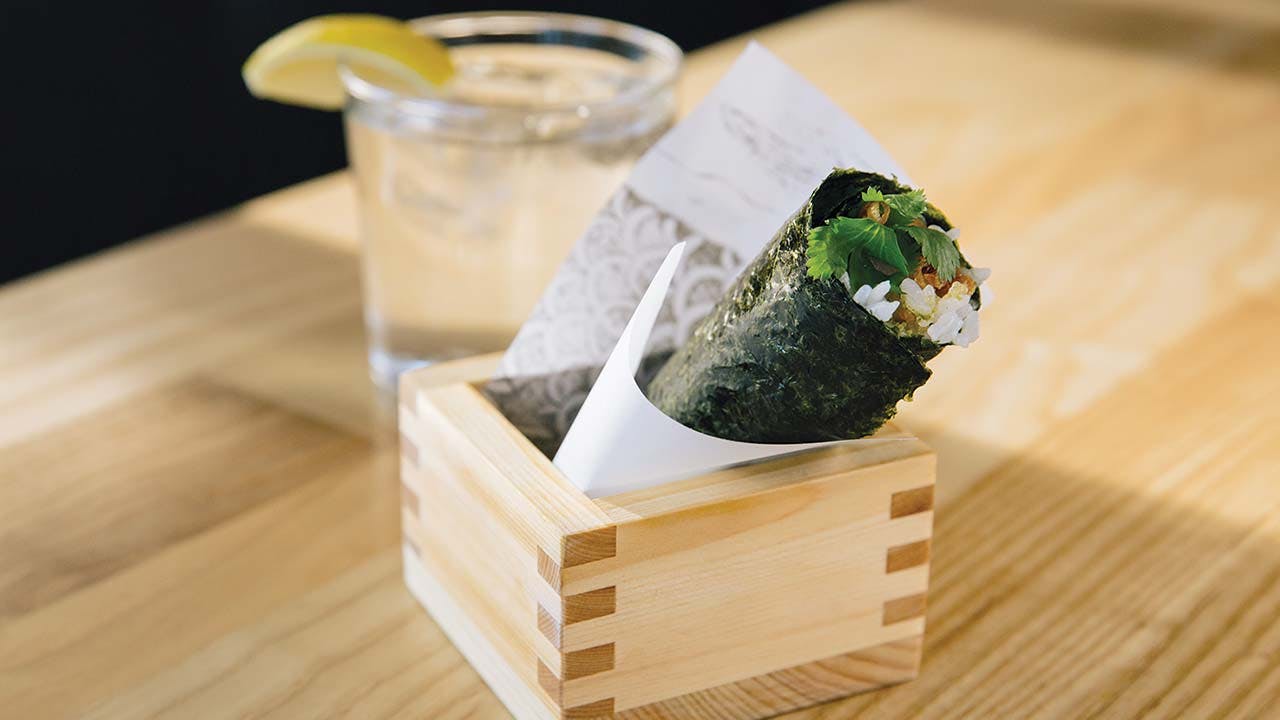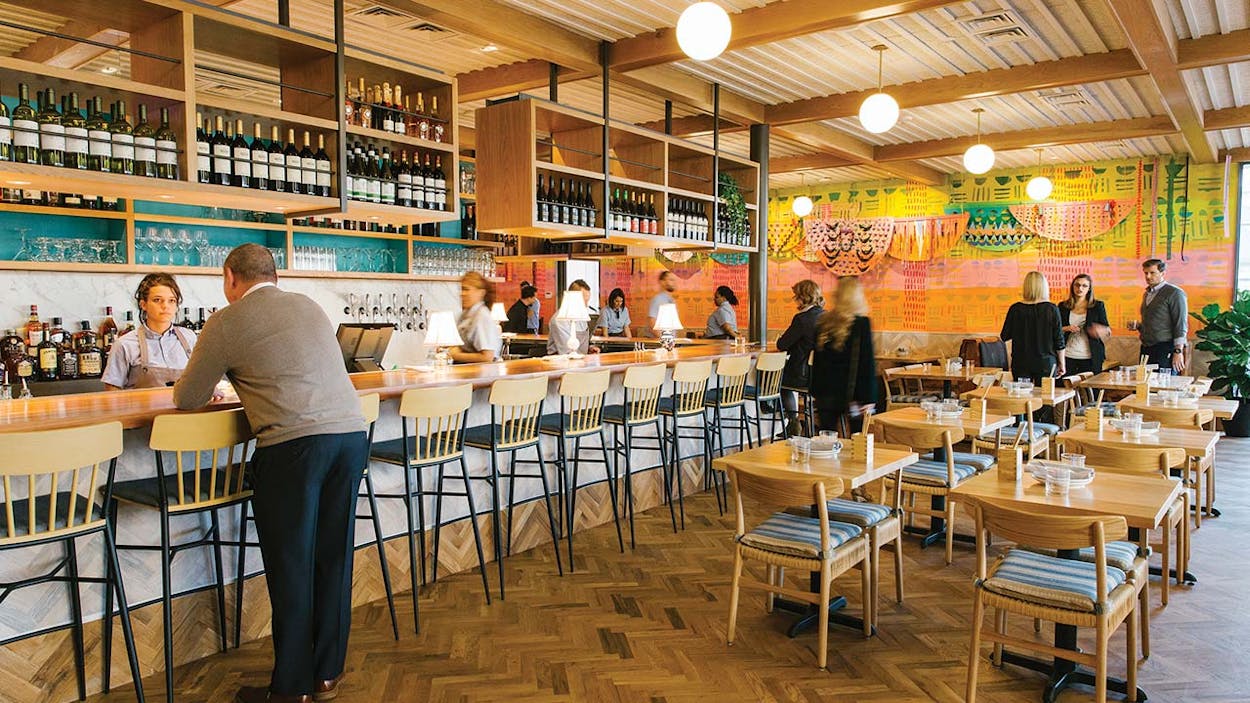Anybody can come down with a case of FOMO, the well-known “fear of missing out.” All it takes is exposure to your friends’ self-congratulatory Facebook posts. Less well-known, if known at all, is FOMU, or “fear of messing up,” which is often triggered by a debilitating sense of responsibility. The staff of three-month-old Dallas restaurant Top Knot suffered from FOMU the entire four months they were developing the menu for the new spin-off of nationally recognized Asian fusion restaurant Uchi. To make matters worse, they had another affliction: fear of being invisible. They were scared that even if Top Knot was full every night, it would never be more than “Uchi’s little brother,” the place where you go have a drink before your table is ready downstairs.
The concern was understandable. Uchi and Top Knot are in the same building, but Uchi has the more visible first floor and Top Knot is upstairs. Both are new to Dallas, but Uchi has well-established locations in Austin and Houston, whereas Top Knot has no history at all. Uchi’s founding chef, Tyson Cole, won a James Beard award in 2011, but Top Knot’s chef de cuisine Angela Hernandez is unknown. (It should be said that the Cordon Bleu graduate does have impressive professional chops, having worked at Restaurant Gordon Ramsay in New York as well as at Uchiko, Uchi’s real little brother, in Austin.)

They needn’t have worried. From the day it opened, Top Knot hasn’t been anybody’s kid brother. Yes, it’s part of the family, but its identity is its own. Like Uchi, it is well designed but lighter and more whimsical, with blond wood, lots of glass, plants, and fluttery yellow, green, and pink canvas wall hangings. Unlike Uchi, it has a full bar, with cocktails and Japanese whiskeys. Like Uchi, its menu is Asian fusion, but its list is shorter and more varied, with the occasional Western influence.
The first time I visited the restaurant, not long after Valentine’s Day, my friends and I arrived so ridiculously early that we had the whole place to ourselves. We were tempted to sit on the balcony; it has tables and wire chairs with comfy turquoise cushions, not to mention a bird’s-eye view of a tree-lined stretch of Maple Avenue. But the day was growing chilly, so instead we claimed the best seat in the house, a corner banquette where we could sit close and talk and share plates to our hearts’ content.
Given that it was happy hour, we took some time to study the concise drink menu, finally deciding on a Mezcal Mule (the smoky Mexican spirit mellowed with ginger beer and passion fruit) and a Fox’s Wedding (sake, citron vodka, cranberry, grapefruit). Of course, after this we needed sustenance, so we settled on Tiger Cry Bao, Top Knot’s version of a pork bun, featuring tender boneless short rib, carrots, cucumber, and cilantro in a combination that echoed a Vietnamese banh mi. And then we couldn’t stop, ordering yuca chips (accompanied by a vivid green swath of edamame “hummus”), a hand roll, and a bowl of sweet, knobby fried sunchokes with a horseradish-and-lemon crème fraîche.

The apps had their intended effect, so we scanned the menu for more. Almost simultaneously, the four of us spotted the scallop crudo. A very Uchi creation, it was a beautiful study in pink and green, with translucent slices of shellfish dabbed with tart, hot yuzu kosho in a Thai coconut milk marinade. It was so light that we felt justified in ordering some rice cakes (onigiri) with kimchi caramel. Not being a rice freak, I found the patties best as a vehicle for the thick, funky sauce—Uchi’s fabulous Vietnamese-inspired “fish caramel” given a spicy kimchi backbeat.
At this point our efficient and informative server showed up to tout the whole fried fish. Tell us about it, we said, and she proceeded to describe a Mediterranean sea bass jacketed in a light, flaky batter, with bonus material in the form of raw carrots and green papaya matchsticks. It arrived exactly as described, and very dramatic looking, but it needed many squeezes of lime and large pinches of black lime–seasoned salt to make it as exciting as our kicky starters.
A few weeks later, another friend and I went back for a quick reprise, and out of curiosity we decided to see how easy it would be to put together a meal for someone who wasn’t into Asian fusion. The answer was very easy indeed. In quick succession, we found a steak, potatoes, and broccoli that any steakhouse would have been proud to offer. We did gulp at $60 for four ounces of strip loin, but Japanese Miyazaki A5 is arguably the finest beef in the world. Cooked rare and sliced, the meat came arrayed on a cutting board, ebony-crusted and deliriously fat-marbled, sided by wafers of black truffle. For the potato component, we ordered diminutive baked purple and white papas canarias splashed with an herbal salsa verde that Hernandez adapted from a recipe of the grandmother of one of her sous chefs. The final element was skinny, leafy gai lan, a.k.a. Chinese broccoli, generously sprinkled with a citrusy white ponzu that substituted nicely for the usual steakhouse lemon half.
By this time, we were at dessert. The choices here were easy, trending Western in overall flavor profile. We chose the pear nabe (which had been called Asian cobbler à la mode in an earlier menu version). It was a homey dessert—“nabe” means “cooking pot”—with chunks of pear and golden raisins in a creamy caramel sauce. A crowning scoop of savory miso ice cream echoed that most American of dessert toppings: a slice of cheddar on apple pie. When we left, the place had almost filled up with a youngish crowd, sipping cocktails and ordering plates both small and large. I didn’t see anyone who looked impatient, like they were waiting for a table downstairs. These people were here for the night.
Top Knot: 2817 Maple Ave, Dallas (214-855-1354). D 7 days. B Sun. $$–$$$
Opened: February 3, 2016
- More About:
- Pat’s Pick
- Dallas









